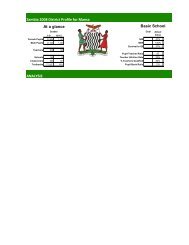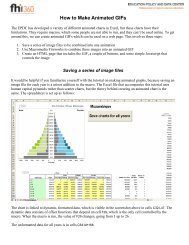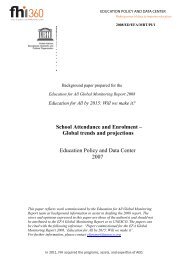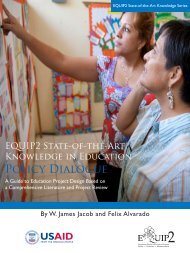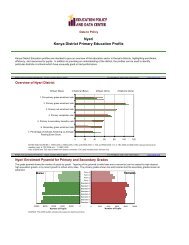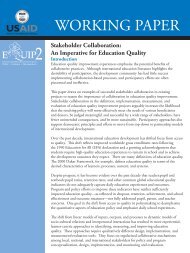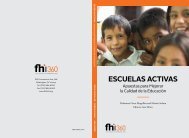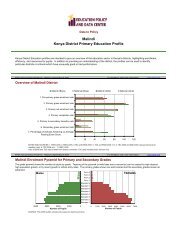EQUIP2 Final Report.pdf - Education Policy Data Center
EQUIP2 Final Report.pdf - Education Policy Data Center
EQUIP2 Final Report.pdf - Education Policy Data Center
Create successful ePaper yourself
Turn your PDF publications into a flip-book with our unique Google optimized e-Paper software.
16<br />
<strong>EQUIP2</strong> Leader Award <strong>Final</strong> <strong>Report</strong><br />
effectiveness of complementary education programs and 2) the high expense<br />
when government programs fail. <strong>EQUIP2</strong>’s dissemination of the findings<br />
prompted many development practitioners to consider the importance of<br />
school quality and in particular, school effectiveness. As evidence of the<br />
research’s broad and deep impact, the term “complementary education” is<br />
now regularly used in both academic and development literature. In fact,<br />
a recent search in the <strong>Education</strong> Resources Information <strong>Center</strong> (ERIC)<br />
identified the term in 16 different academic publications.<br />
There were also challenges and critiques to the research. Critics argued that<br />
because complementary education programs are dependent on volunteer<br />
teachers and donations, they are inherently unsustainable and therefore, offer<br />
few applicable lessons to governments. In most cases where governments<br />
had taken ownership of complementary education programs, the schools<br />
lost the characteristics that had made them cost-effective in the first place.<br />
In addition, the research provoked sensitivities because of the inherent<br />
insinuation that governments are failing to effectively provide educational<br />
services, especially to the most vulnerable populations.<br />
Despite these critiques, however, members of the education policy expert<br />
team felt that, overall, the research caused development practitioners to be<br />
more thoughtful about the role of complementary education programs in<br />
efforts to achieve EFA. As one member commented, “The complementary<br />
education research hasn’t resulted in a huge sea change, but there has<br />
been a shift. If you look at the work of the World Bank and other donors,<br />
the organizations are much more receptive to complementary education<br />
programs now, as a result of <strong>EQUIP2</strong>’s research.”<br />
School Effectiveness and the Opportunity to Learn<br />
The findings from <strong>EQUIP2</strong>’s complementary education research concluded<br />
that non-governmental schools were more effective than government<br />
schools, largely because the schools were accountable to the local community<br />
and created an environment that emphasized learning. In response to<br />
these findings, <strong>EQUIP2</strong> researchers began to examine some of the basic<br />
components that needed to be in place to ensure students could learn.<br />
Through a literature review, the team identified the key indicators of a basic<br />
Opportunity to Learn (OTL): the number of days the school is open, teacher<br />
attendance, student attendance, teacher-student ratio, instructional materials<br />
per student, time spent on task, and reading skills. This framework was<br />
derived from a relatively simple premise: learning is to some degree a function<br />
of time and effort. Without adequate time spent on task, no learning is<br />
possible.




